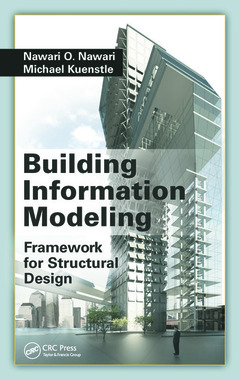Building Information Modeling Framework for Structural Design
Auteurs : Nawari Nawari O., Kuenstle Michael

BIM for Structural Engineering and Architecture
Building Information Modeling: Framework for Structural Design outlines one of the most promising new developments in architecture, engineering, and construction (AEC). Building information modeling (BIM) is an information management and analysis technology that is changing the role of computation in the architectural and engineering industries. The innovative process constructs a database assembling all of the objects needed to build a specific structure. Instead of using a computer to produce a series of drawings that together describe the building, BIM creates a single illustration representing the building as a whole. This book highlights the BIM technology and explains how it is redefining the structural analysis and design of building structures.
BIM as a Framework Enabler
This book introduces a new framework?the structure and architecture synergy framework (SAS framework)?that helps develop and enhance the understanding of the fundamental principles of architectural analysis using BIM tools. Based upon three main components: the structural melody, structural poetry, and structural analysis, along with the BIM tools as the frame enabler, this new framework allows users to explore structural design as an art while also factoring in the principles of engineering. The framework stresses the influence structure can play in form generation and in defining spatial order and composition. By highlighting the interplay between architecture and structure, the book emphasizes the conceptual behaviors of structural systems and their aesthetic implications and enables readers to thoroughly understand the art and science of whole structural system concepts.
- Presents the use of BIM technology as part of a design process or framework that can lead to a more comprehensive, intelligent, and integrated building design
- Places special emphasis on the application of BIM technology for exploring the intimate relationship between structural engineering and architectural design
- Includes a discussion of current and emerging trends in structural engineering practice and the role of the structural engineer in building design using new BIM technologies
Building Information Modeling: Framework for Structural Design provides a thorough understanding of architectural structures and introduces a new framework that revolutionizes the way building structures are designed and constructed.
Introduction. Structure and Architecture Synergy Framework (SAS Framework). Introduction. Building Information Modeling. Modeling Elements. Architectural Elements. Structural Analysis. Index.
Dr. Nawari, (Ph.D., P.E., M.ASCE) has over 20 years of experience in design, teaching, and research specializing in building structures and building information modeling. Currently, he teaches graduate and undergraduate courses at the University of Florida. He has written and co-authored over 70 publications and three books. He is an active member of the U.S. National Building Information Modeling Standard Committee (NBIMS), BIM Committee of the Structural Engineering Institute (SEI), and co-chair of the subcommittee on BIM in education and many other professional societies. Dr. Nawari is also a board certified professional engineer in the states of Florida and Ohio.
Michael W. Kuenstle
Date de parution : 05-2015
15.6x23.4 cm
Thème de Building Information Modeling :
Mots-clés :
BIM Model; BIM; rald; BIM Platform; esign; Analytical Model; platforms; Le Ve; rstru; Structural Melodies; ctu; Traditional Cad; option; Properties Palette; bar; Bending Moment Diagrams; structural; Load Family; melodies; Quick Access Toolbar; properties; BIM Tool; BIM Environment; BIM Design; Dialog Box; Structural Poetry; Fo Ot; Shear Force Diagram; Tekla Structures; Analyze Tab; Mass Floors; Structural Floor; Properties Panel; Curtain Systems; Options Bar



